 Strategic Communication Examples
Strategic Communication Examples
Internal barriers of communication impact negatively on employee morale, productivity, and business success. Learn how to overcome them and succeed.

.png)
Strategy is an important component of internal communications. Ensure you’re communicating through the right channels at the right frequency with our Internal Communications Channel Audit worksheet.
Access NowIn any organization, effective internal communications can be the difference between success and failure. It drives clarity, fosters teamwork, and enables informed decision-making. However, there are many barriers that can hamper the flow of communication within an organization, from a lack of clear objectives to hierarchical structures and cultural differences.
Research indicates that the annual cost of ineffective communication in the United States alone is estimated to account for trillions of dollars. It also points to poor communication as a major factor. In its State of the American Manager Analytics and Advice for Leaders report, Gallup states:
“Gallup has found that consistent communication — whether it occurs in person, over the phone, or electronically — is connected to higher engagement.”
In its State of the Global Workplace 2023 report, Gallup revealed that employees who are “actively disengaged” cost the world $8.8 trillion in lost productivity in 2022. In its State of the Global Workplace 2024 report, the company estimates that low employee engagement costs the global economy even more — US$8.9 trillion, or 9% of global GDP. This shows that effective internal communications and employee engagement are intertwined, and it’s getting worse.
There is no doubt that engaging employees requires effective communication skills. But it also requires a palpable understanding of the internal barriers that can impede effective internal communications.
We set out to find the most common internal barriers that impact communication and decided on seven of them, which we analyze in this post. We also explore why internal barriers occur and provide actionable strategies to overcome and prevent them.
How effective is your internal communications strategy? Do you do regular audits to ensure it remains aligned and impactful? If you don’t, you can easily lose track of how engaged your employees are — or aren’t. Get valuable insights by using Cerkl’s free audit template today.
Download Your Free Strategic Internal Communications Audit Template Now
Our template will enable you to assess how well your internal comms are working and how your employees feel. You’ll be able to assess the core competencies, shortcomings, growth potential, and challenges of your comms, and move forward accordingly.
Effective internal communication is critical in every organization as it enhances transparency, trust, and cooperation among team members. Communication skills also promote a common language, reducing the misinterpretation of messages. Developing these skills leads to an increase in productivity, employee morale, and ultimately, organizational success.
Effective internal communication also plays a key role in goal-setting. An open dialogue between management and employees encourages the sharing of ideas, fostering a collaborative environment. Clear and transparent communication about organizational objectives helps to focus the efforts of all team members toward achieving them.
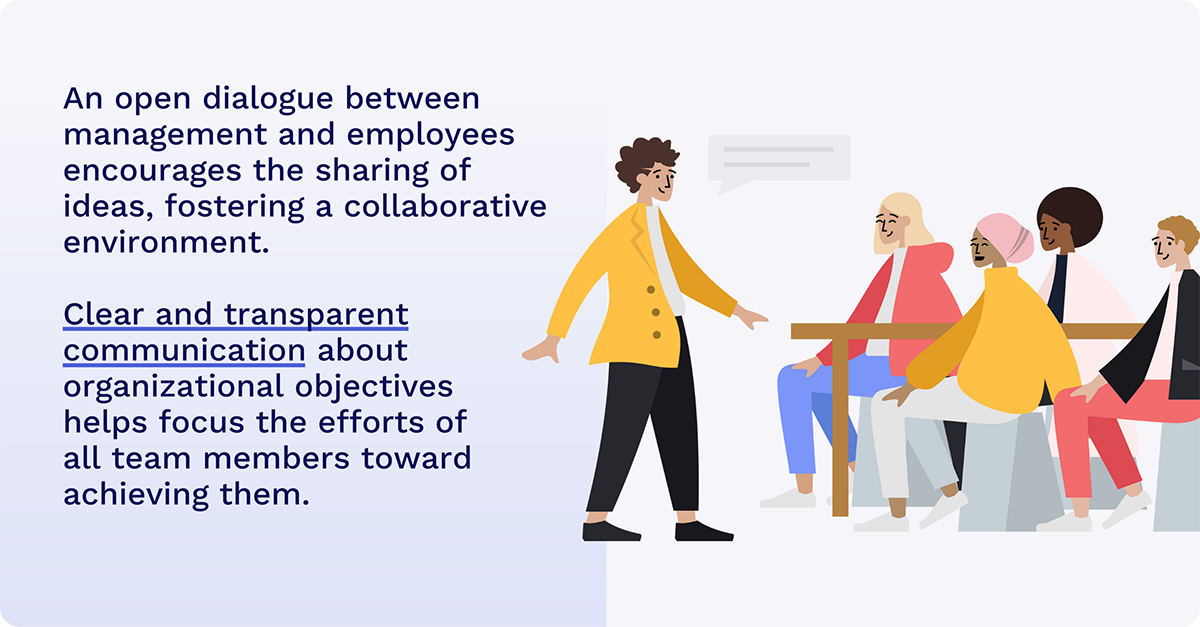
Employees agree that miscommunication and communication barriers contribute to all kinds of problems in the workplace. A survey undertaken by The Economist in 2017-2018 shows how poor communication impacted productivity, morale, and the bottom line in U.S. companies. More specifically, they said it added stress (52%), contributed to project delays or failures (44%), low morale (31%), unmet goals (25%), and lost sales (18%). While 18% might not seem a large percentage, respondents composed of managers, senior executives, and junior staff at organizations, said 30% of these were valued at between $100,000 and $999,999 per sale.
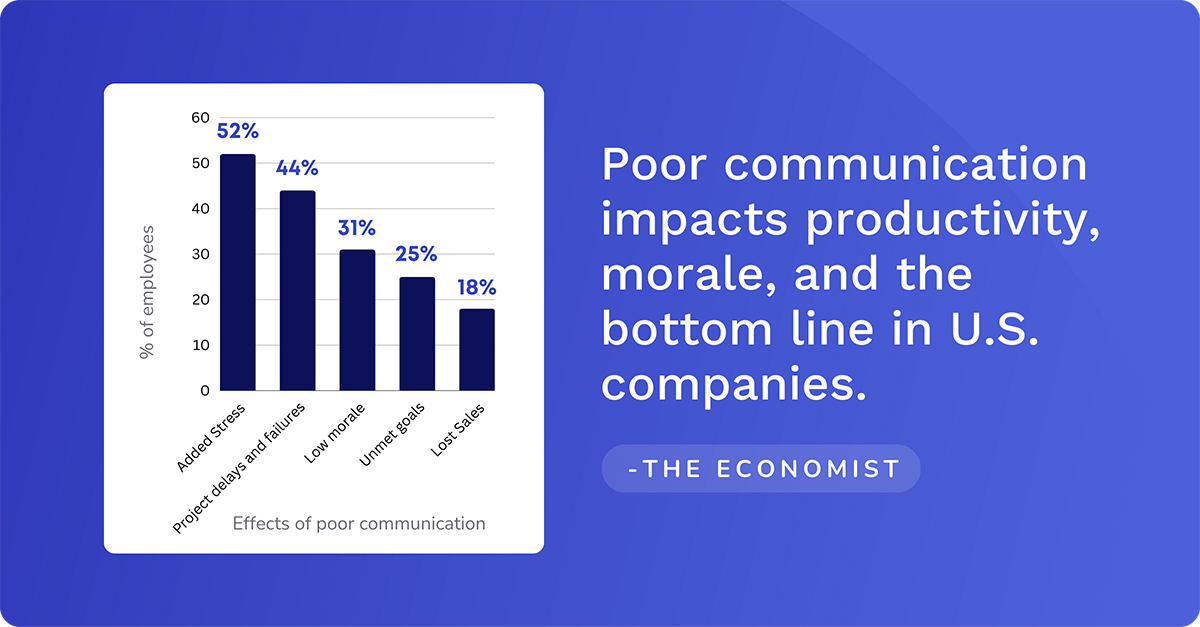
While the numbers may have changed, the effects of inadequate internal communications haven’t. The Harris Poll/Grammarly 2023 The State of Business Communication report highlights that poor communication’s effect on productivity was 43% in 2022, which is a significant increase compared to 28% in 2021. The Economist report, states that high stress levels caused by poor communication in the workplace continue to increase. The figures quoted for lost business are also similar, rising to 20% in 2021 and dropping slightly to 19% in 2022.
Internal barriers of communication often hinder the transfer of knowledge and information in the workplace. Some common internal communication barriers include language differences, lack of clarity in messages, hierarchical structures in the organization, and unresolved conflict. Understanding and addressing these barriers is crucial to promote effective communication.
Upgrade your company’s internal comms to enhance employee communication
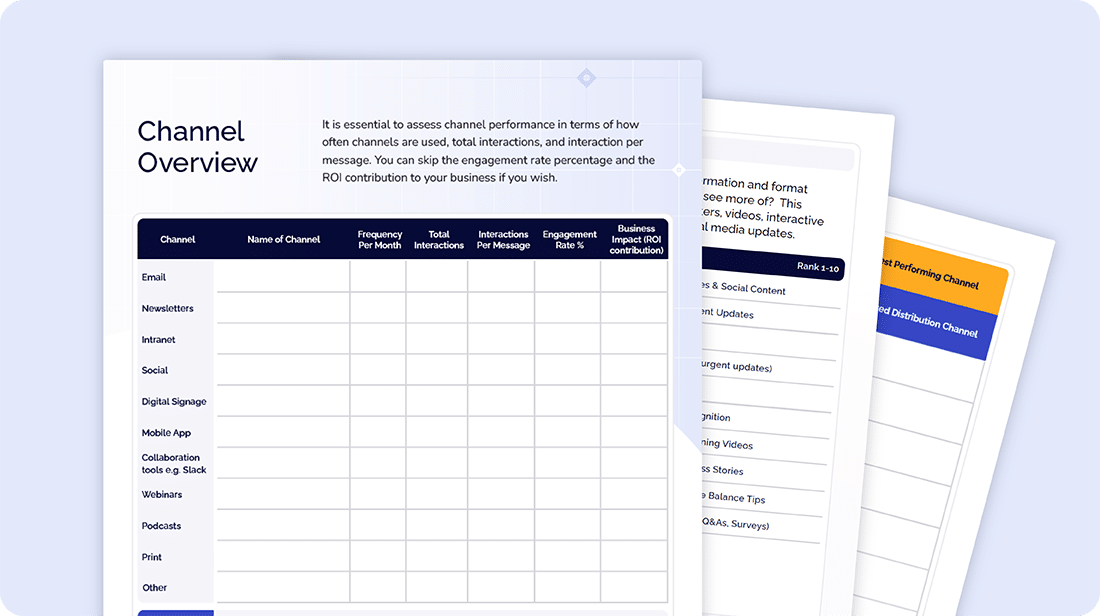
One of the most common internal communication barriers is a lack of clear goals and objectives. Unclear goals lead to confusion and decreased employee morale as employees may struggle to understand their role within the team or the overall direction of the organization.
The use of business language or corporate jargon can sometimes confuse employees, preventing them from understanding organization goals clearly. This highlights the need for a common goal or mission in the workplace. Clear communication ensures that everyone is on the same page and understands what is expected of them.
Employees in companies with clear goals find it easy to work with others from different departments. In its 2023 The Anatomy of Work Global Index, Asana focused on the effects of cross-functional (XFN) collaboration on business. Their survey, which involved 9,615 global knowledge workers, identifies three key insights common to all industries.
Furthermore, 92% of employees working for companies with clear, connected goals at collaborative organizations said their work had value, and 87% said their organization was well-prepared to meet customer expectations. Asked how they respond to challenges, 79% of employees at collaborative organizations with clear, connected goals said they were well-prepared to respond to challenges. When compared with responses of employees from weak collaborative organizations with no clear, connected goals, the percentages dropped to 50%, 37%, and 20% respectively.
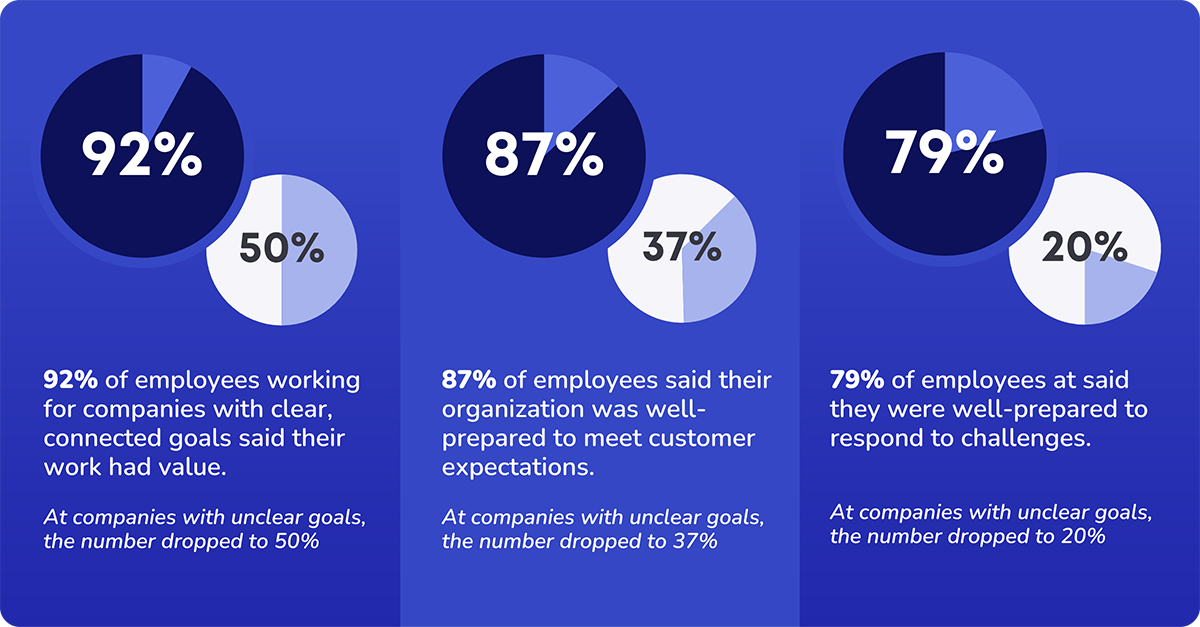
“Effective collaboration helps teams realize goals faster - and those achievements matter most.”
Asana
They also found that when individual objectives, employees were more likely to share information (83% vs 24%). Ultimately, 71% of employees working at organizations with clear goals had no problem working with stakeholders in other functions.
Setting SMART (Specific, Measurable, Achievable, Relevant, and Time-bound) goals is an effective strategy for clear communication in goal-setting. This well-known approach provides a clear and concise path towards the fulfillment of objectives.
Leaders should ensure that the channels of communication are not clogged by emotional disconnects and listening barriers. One-on-one meetings, team gatherings, and town halls can also provide opportunities for employees to air their views, thus promoting transparency.
Information overload occurs when an individual receives too much information at once, making it difficult to fully process and understand. With the rise of digital technology and constant connectivity, information overload has become a major barrier to effective internal communications.
One common example is email inbox overload. Email inboxes are constantly flooded with messages, making it hard to focus on the most important ones. This can lead to missing key information. Based on current data from Statista, the global daily volume of emails sent and received in 2023 is 347.3 billion, marking a 4.3% rise from the 2022 figure of 333.2 billion emails per day. They predict that these figures will rise to 361.4 billion in 2024, 376.4 in 2025, and 392.5 in 2026.
Internal communicators should aim to sharpen their communication skills by condensing information and being concise. To avoid overwhelming recipients, only the most crucial details should be highlighted. The main ideas and calls to action should be emphasized so that key takeaways are not lost in the shuffle. Being mindful of limiting unnecessary info and recognizing audience limitations is important when it comes to overcoming the communication challenges of information overload.
Upgrade your company’s internal comms to enhance employee communication

Unfortunately, only a relatively small percentage of workers (less than half) say they workers have a straightforward method for providing feedback on important communications. But the reality is that poor feedback systems can cause numerous challenges such as poor listening, selective perception, and decreased employee morale. These factors can negatively impact the organizational culture, preventing effective internal communications. Research also shows that a lack of feedback can lead to increased instances of workplace gossip and further degrade the communication environment.
Create feedback mechanisms supporting open dialogue and active listening for overcoming communication barriers. Through feedback and constructive criticism, team members will have a clearer understanding of what is expected of them. Integrating feedback in a conversational manner, and emulating a collaborative environment can help to reform organizational behavior and make it more transparent and accountable.
“Take charge of transparent communication so that fake news, rumors, and gossip don't undermine the work you are doing to drive the performance and engagement of your team.” Gallup
Hierarchical structures in organizations can often act as an internal communication barrier. For example, the typical top-down communication model prevalent in many organizations can hamper open, transparent communication channels and restrict information sharing.
Furthermore, rigid hierarchies can lead to potential silos within the organizational structure. As a result, the opinions of lower-level team members may not be viewed or considered seriously, potentially leading to an emotional disconnect.
“The art of communication is the language of leadership.”
James Humes, speechwriter for five U.S. presidents
For an organization to succeed, it's crucial to foster an environment of open communication. Leaders should encourage employees to voice their concerns, share ideas, and participate in decision-making, regardless of their rank. Similarly, teams should consciously avoid corporate jargon that could act as a communication barrier. While jargon isn’t necessarily bad, it can leave people feeling confused and frustrated. On the other hand, active steps toward promoting a culture of inclusivity and transparency can lead to organizational success.
Barriers of internal communications often manifest as cultural and language differences. In diverse workplaces, team members may have difficulty understanding each other due to language differences. Additionally, different cultural norms can lead to misunderstandings and unnecessary clashes.
Recognizing the role that culture and language play in communication is a soft skill that should be mandatory. Without this understanding, the use and interpretation of corporate jargon can quickly become a common internal communication barrier.
“Teams need better communication skills to foster diversity and inclusion.”
The Harris Poll/Grammarly 2023 report
Overcoming internal barriers related to culture and language requires a strategic approach. A recommended strategy is to establish a common style of language for communication within the organization. The use of simple, clear language minimizes misunderstandings and caters to those with varying levels of language proficiency. Open dialogue and transparent communication also help bridge these gaps.
One of the most common internal communication barriers in an organization is ambiguity about roles and responsibilities. This can lead to a lack of clarity about who is responsible for what and may result in miscommunication, misunderstandings, and conflicts. For example, a team member might be given a task that should have been assigned to someone else, causing confusion and delay in task completion.
A proper understanding of individual roles and responsibilities fosters effective communication. This can be achieved through setting goals, allocating tasks clearly, and ensuring there are regular updates. Human resource (HR) training can provide guidance on defining roles distinctly. Tools like Responsibility Charting, a chart that outlines who is responsible, accountable, consulted, and informed about every task can be useful.
Resistance to change is another common internal communication barrier. This can manifest in various ways including an aversion to new communication tools and channels. For instance, an employee may prefer traditional email over new collaborative tools, or in-person meetings over virtual ones. If not addressed, this may lead to an organizational culture that inhibits innovation and progress.
Overcoming resistance to change requires a strategic approach that starts with understanding the reasoning behind resistance. Enhancing so-called soft skills and promoting trust within the team are crucial for fostering openness.
It's also important to reiterate the benefits of adapting to changing technology and tools to the team members. Encouraging employees to voice their concerns and suggestions also significantly contributes to fostering a culture of open communication.
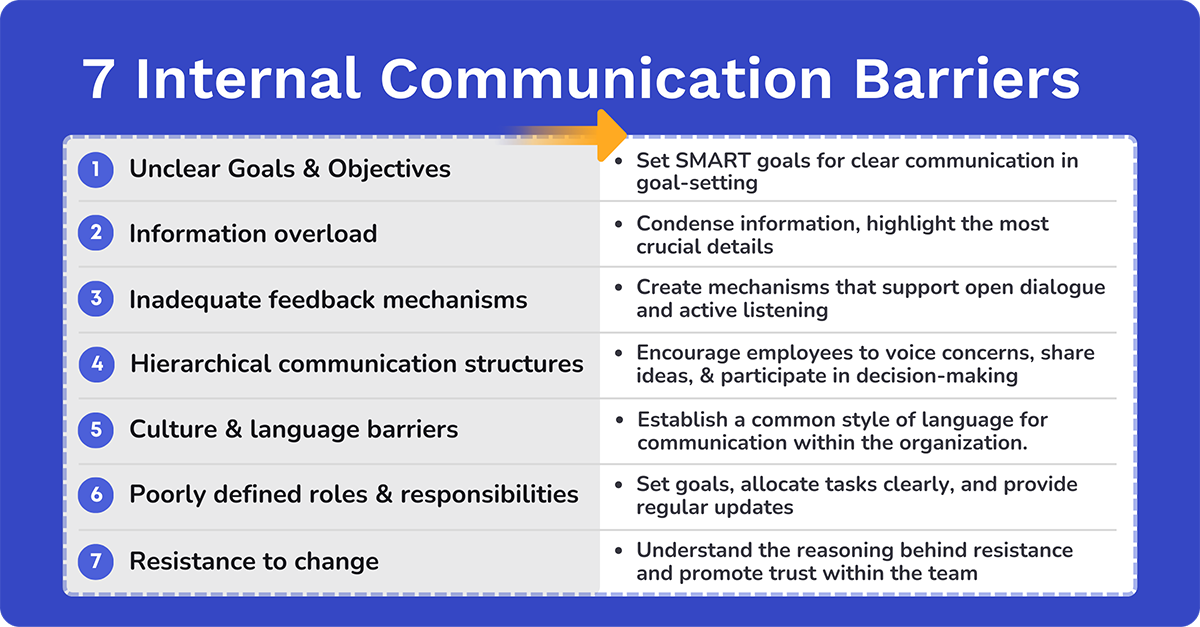
Do you recognize internal barriers that may be impacting internal communications in your organization? Cerkl Broadcast software can help you improve your communication skills right now. Broadcast’s omnichannel capability removes the risk of information overload because your employees can choose the channels they want to use instead of being bombarded on all fronts with messages that might say the same thing. You can also segment your audience and schedule internal communications so that employees receive the required information at the right time, wherever they are. Additionally, Broadcast offers flexibility so you can decide how to deliver internal communications, avoiding hierarchical structures.
It’s vital to have efficient feedback mechanisms, which is another capability Broadcast delivers together with invaluable analytics tools. And if you’re facing inevitable change issues, you’ll find that the platform is ideal for change management communications in the midst of unexpected challenges.
Want to know more? Let’s talk about how Cerkl Broadcast can help you overcome those internal barriers that so often threaten effective internal communications.
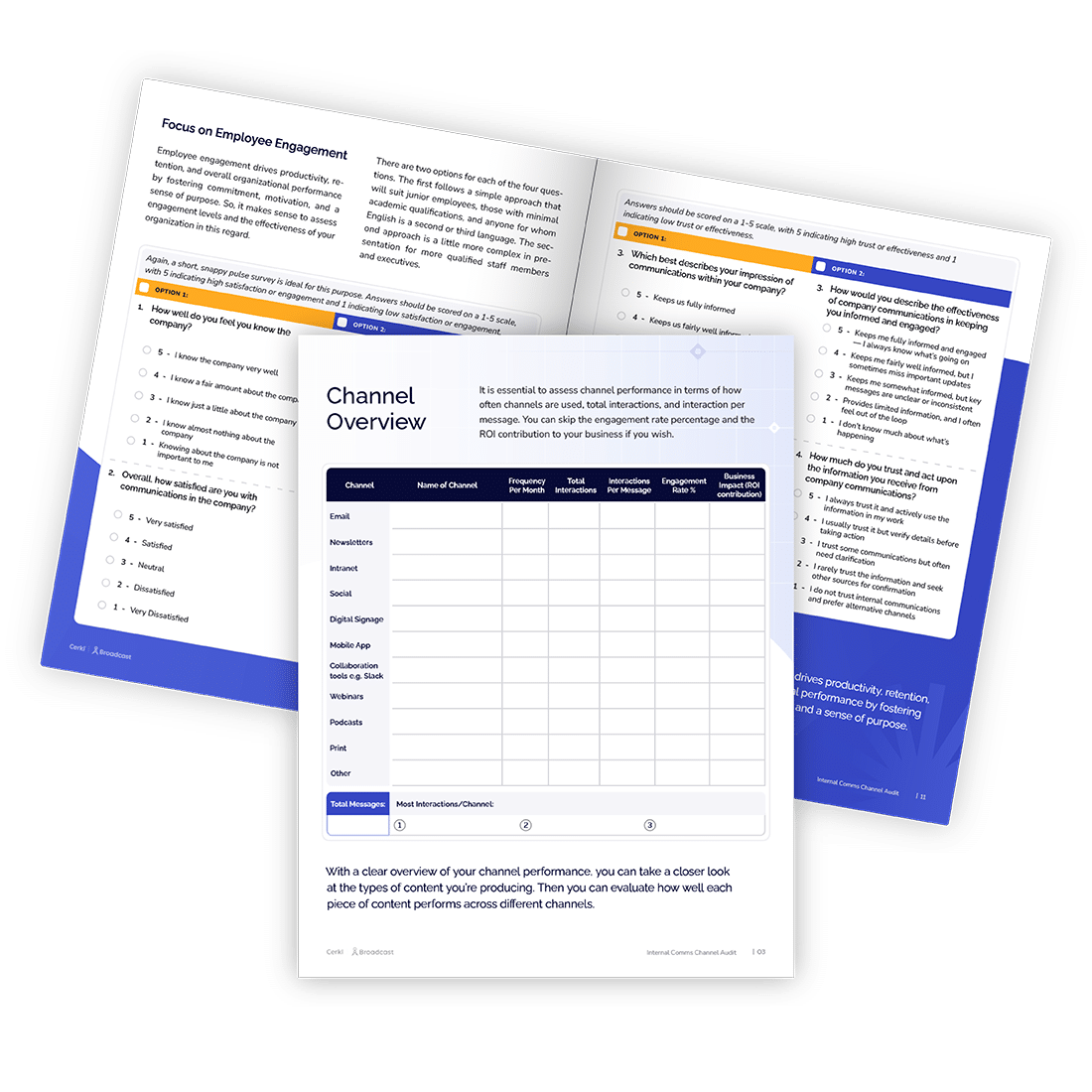
Upgrade your company’s internal comms to enhance employee communication
What are internal communication barriers? There are many different types, but in general terms, these barriers prevent or hamper effective internal communications in various ways.
What is an example of an internal barrier of communication? Hierarchical communications are an example of an internal barrier that could negatively impact internal communications.
How to overcome internal barriers of communication? Once you have identified the barriers that are threatening the internal communications in your organization you can address the problem and take action. For example, if there are major changes in the organization, it pays to establish a change management communication strategy that will keep employees informed.
What are the 5 barriers of communication? We’ve mentioned two in these FAQs already, the other five we pinpointed in this post are a lack of clear goals and objectives, information overload, feedback mechanisms that aren’t adequate, language and cultural barriers, and poorly defined roles and responsibilities.

Upgrade your company’s internal comms to enhance employee communication